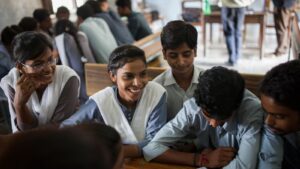Education: Prospects and Challenges
(Relevant for GS Paper-3)

Education, derived from the Latin term “educare”, signifies the process of instilling, nurturing, and cultivating exceptional attributes in a child.
Historical Overview of Education in India
India boasts a rich legacy in knowledge dissemination. In ancient times, the ‘gurukula’ system was prevalent, wherein the disciples or ‘shishyas’ lived and learned under the same roof as their guru. Nalanda, the world’s earliest university model, was situated in India, attracting learners globally due to its advanced knowledge systems.
Various fields of knowledge originated in India, emphasizing the esteemed value of education in ancient Indian society. However, the country did not witness a renaissance or scientific revolution akin to what occurred in Europe.
The British, who eventually assumed control over Indian affairs, initially showed little regard for education. The progress in this sector was substantially slow during the early period of their rule. Nevertheless, they eventually established the foundation for a modern educational structure, replacing India’s traditional systems with English methodologies.
Despite these advancements, the present Indian education system calls for significant reforms.
Efforts by the Government towards Educational Amendments
- The National Programme on Technology Enhanced Learning.
- The Universal Education Drive, Sarva Shiksha Abhiyan.
- The PRAGYATA initiative.
- The Mid Day Meal Scheme.
- The ‘Save the Girl Child, Educate the Girl Child’ program, Beti Bachao Beti Padhao.
- PM SHRI Schools.
Despite these efforts, the current state of education in India faces significant hurdles such as insufficient infrastructure, minimal government spending on education (less than 3.5% of GDP), and a high pupil-to-teacher ratio in elementary schools, standing at 24:1 according to Unified District Information System For Education (UDISE) data.
Therefore, it is crucial now more than ever to align the Indian Education System with international standards and introduce contemporary, context-relevant learning methods. Furthermore, it’s essential to bring the National Education Policy 2020 into full effect.
Significant Challenges in India’s Education Sector
- Insufficient School Infrastructure: Based on the Unified District Information System for Education (UDISE) 2019-20 report, only 12% of schools offer internet facilities, and a mere 30% have computers. Moreover, 42% of schools lack adequate furniture, 23% lack electricity, 22% lack accessibility ramps for the disabled, and 15% lack WASH amenities (including drinking water, toilets, and hand washing stations).
- Elevated Dropout Rates: Dropout rates remain alarmingly high at primary and secondary levels, with many children aged 6-14 leaving school before completing their education, resulting in substantial financial and human resource wastage. According to the National Family Health Survey-5, 21.4% of girls and 35.7% of boys aged 6 to 17 years cited lack of interest in studies as their reason for dropping out before the 2019-20 school year.
- Issue of Brain Drain: Intense competition for admission into premier institutions such as IITs and IIMs creates a challenging academic environment, leading many Indian students to opt for studies abroad, causing a talent drain in our country.
- While the quantity of education in India has undoubtedly increased, the quality aspect, which is crucial for employability, trails behind.
- Continued Illiteracy: Despite constitutional directives and targeted efforts to improve education, approximately 25% of India’s population remains illiterate, leading to their social and digital exclusion.
- Neglect of Indian Languages: Indian languages are underdeveloped, with English being the primary medium of instruction, especially in scientific subjects, resulting in unequal opportunities for rural students. Additionally, standard publications in Indian languages are scarce.
- Deficiency of Technical and Vocational Education: The predominant nature of our education system is generalistic. The development of technical and vocational education is unsatisfactory, leading to an increase in educated yet unemployed individuals.
- Unaffordability: Low income, especially in rural areas, often relegates education to a secondary priority. Many parents, due to lack of awareness and financial stability, perceive education as an expense rather than an investment, preferring their children to work and contribute to family income. For higher education, scarcity of good institutes locally often necessitates relocating to cities, which incurs additional expenses and leads to lower enrollment rates.
- Gender Inequality: Despite governmental efforts to promote equal educational opportunities for all genders, female literacy rates, particularly in rural areas, remain distressingly low. As per UNICEF, poverty and local cultural practices (like female infanticide, dowry, and early marriage) significantly contribute to gender inequality in education across India.
Ways to Enhance the Education System
- There’s a critical need to incorporate subjects focused on problem-solving and decision-making skills into the school curriculum. This will provide students with a practical learning experience and equip them to face real-world challenges as they transition into the workforce.
- Effective implementation of the National Education Policy (NEP) can significantly rejuvenate the stagnant education system.
- India’s educational structure needs to be improved by integrating vocational education into conventional learning. Additionally, providing proper mentorship in schools, particularly government-run ones, can ensure students receive the right guidance from the outset and gain awareness about potential career paths.
By 2030, India will have the world’s largest youth population. This demographic advantage can only be effectively harnessed if the young population is adequately skilled to participate in the workforce. Quality education will play a pivotal role in this aspect, making it crucial to implement appropriate measures promptly.
Follow us :
-
https://www.instagram.com/triumphias
https://www.youtube.com/c/TriumphIAS
https://t.me/VikashRanjanSociology
Find More Blogs
Scope of the subject and comparison with other social sciences
Changing family structure in India Modernity and social changes in Europe
Indian Education System, Educational Reforms in India, Challenges in Education, Prospects of Education, Education Policy in India, Dropout Rates in India, Gender Inequality in Education, Role of Government in Education, Future of Education in India, Infrastructure in Indian Schools, Brain Drain, Literacy Rates, Indian Languages in Education, Technical and Vocational Education.#Sociologyforupsc #sociologyforupscinhindi #sociologyforupscgs1 #sociologyforupscprelims #sociologyforupscinenglish #sociologyforupscmainsinhindi #sociologyforupscoptionalinhindi #sociologyforupscmains #sociologyforupscplaylist #sociologyforupsclecture1 #sociologyforupsccse #sociologyforupscoptional #syllabusofsociologyforupscoptional #bestbookforsociologyforupsc #sociologyoptionalforupscanswerwriting #sociologyoptionalforupscanukumari #sociologyoptionalforupscabhijeet #sociologyoptionalforupscanalysis #sociologyoptionalforupscalllectures #sociologysyllabusforupscanalysis

